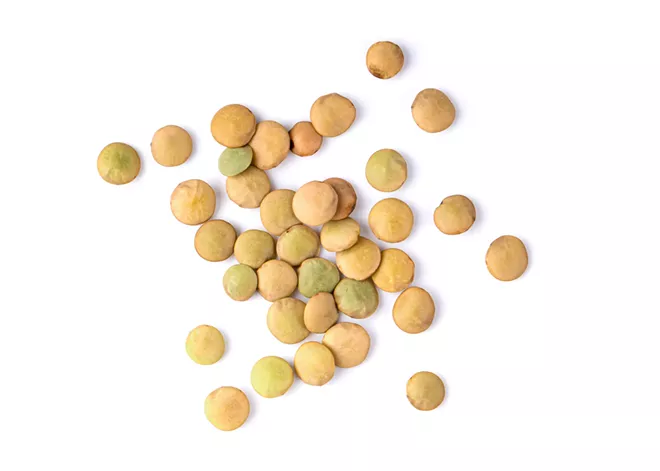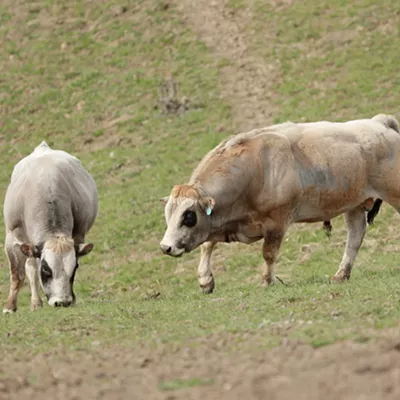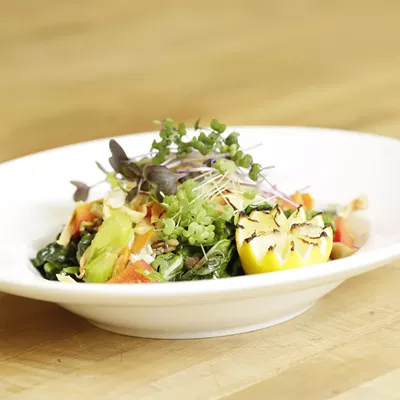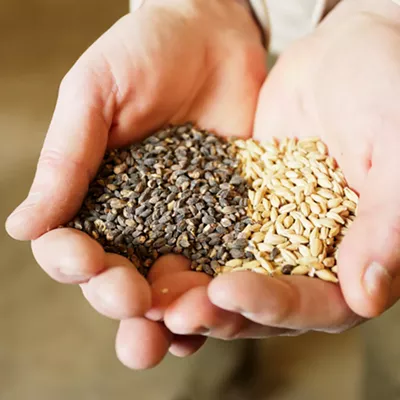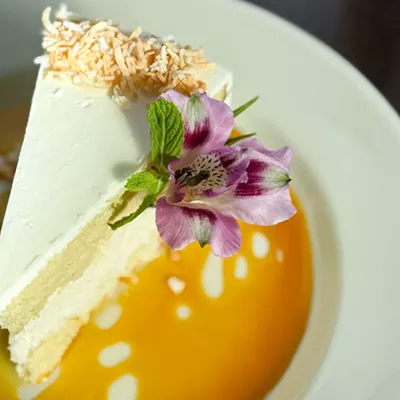Late August is Tase T. Lentil's time to shine. The 5-foot-something, anthropomorphized legume mascot celebrates Pullman's National Lentil Festival with live music, a 5-kilometer run and the world's biggest chili bowl. He dances, poses and puts in the work to make sure people fall in love with lentils. But after the festivities, he and his kin all but disappear.
About 45,000 acres of lentils were planted in Washington state in 2022, producing over 43 million pounds of food, according to the U.S. Department of Agriculture. A pound of lentils has more protein than a pound of steak, despite having one-tenth the carbon footprint. Lentils take little to no fertilizer, fix nitrogen back into the ground and don't need irrigation. A recent study suggests that the carbon footprint of the entire life cycle of all American pulse crops — legumes harvested for their nutritious edible seeds, like beans, peas and chickpeas — could be offset by a small farm of 110 wind turbines.
Palouse lentils could be an affordable, healthy and environmentally conscious choice for Inland Northwest foodies and chefs concerned about eating local. But despite Tase T.'s efforts, lentils and other pulse crops aren't ending up on local restaurant menus or downtown dinner tables. Why?
The abundance of lentils is actually part of the problem. Major processors buy and sell thousands of pounds of lentils at a time. Nearly 90% of U.S. lentil crops are exported to Spain, Turkey and other international markets that gobble them up by the ton.
No restaurant in Spokane is ready to buy a literal ton of lentils. But there aren't many smaller companies nearby that can repackage 2,000 pound totes into manageable 10, 5, or 1 pound bags. So when chefs scan grocery aisles for menu inspiration, they aren't seeing many local legumes.
Downtown diners don't see them either, except on rare occasions like the new savory lentil and tomato stuffed pastries created by chefs Tony Brown and Peter Adams at Ruins.
Most people assume they don't want to eat lentils. But Josh Lorenzen, executive chef at vegetarian-focused RÜT Bar & Kitchen on the South Hill, has had success getting people to try plant-based food they've never had before.
"There are a lot more adventurous people [in Spokane] than I thought," Lorenzen says. "People are willing to pay for it if it's presented to them in a way that's comfortable to them."
But most chefs aren't creating cozy, exciting lentil dishes, and the cultural imagination around legumes still doesn't extend much past lumpy lentil soup. So when Pullman finishes the world's biggest bowl of chili, the lentil harvest is shipped off to the rest of the world. Eastern Washington forgets about Tase T., his friends, and all their benefits to body and planet.
Aaron Flansburg is a fifth-generation farmer on the Palouse and the current chairperson of the USA Dry Pea and Lentil Council. He farms about 2,000 acres of rotating crops, from soft white wheat to spring barley or canola, to pulse crops like chickpeas, peas or Pardina lentils.
Typically, wheat is the most valuable crop for the area, he says, but that can vary. If fertilizer prices are up, he might choose to plant lentils, which he doesn't have to fertilize. Lentils also put more nitrogen in his soil, which could make the next year's wheat crop even better.
When he grows lentils, Flansburg sells his crop to Spokane Seed. Pardina lentils, also called Spanish browns, are the primary lentil grown in the Palouse.
"They're a firmer lentil than the large green lentils are," Flansburg says. "So when cooked, they have a firmer mouthfeel and would be typically used as a whole lentil in soups or the like. That's my favorite kind of lentil to grow and to use, personally."
Flansburg isn't alone. Spaniards love Pardina lentils, which were originally grown in the Pyrenees mountains between Spain and France and are stars of traditional Spanish stews. Now, most of Spain's lentils are grown in the Palouse. Andrew Fontaine, president of Spokane Seed, says that his company alone provides over 80% of Spain's lentils every year.
Flansburg's lentils most likely end up on the Iberian Peninsula. If he grows peas or chickpeas, Spokane Seed probably sells them to major companies like Campbell's, Heinz, General Mills and Goya, which may ship them across the country or across the world. With such huge customers, it's not financially reasonable for Spokane Seed to sell to smaller markets. If locals are looking to go to the farmer themselves, buying direct is usually impossible.
"There's a guy that I got a call from just really out of the blue who is a body builder in California," Flansburg says. "He was eating a vegetarian diet, if not a vegan diet, and he loved lentils. And he says, 'Well, how can I get lentils from you directly?' And I had to tell him, 'I don't have a way to clean them safely enough and thoroughly enough for me to sell them directly to you.'"
An exception to this farm-to-buyer snag is Palouse Brands, run by Sara and Kevin Mader and their family. They decided to become a "vertically integrated" farm that does everything from planting to packaging so they could control where their crops end up. Their women-led team of growers, packagers, branding pros and customer service employees enables them to sell their product directly to local consumers.
"It makes Palouse Brand extra special that we're able to work with them and that they're a family farm in our region that wants to be able to sell lentils and pulses more locally," says Michelle Youngblom, crop promotions manager at LINC Foods, a cooperative dedicated to connecting small Northwest farmers to local eaters. LINC offers Palouse Brand beans and lentils as a plant protein add-on to their subscription-based, community-supported agriculture (CSA) boxes.
Both Palouse Brands and Youngblom create recipes to help people imagine new ways to use lentils, like a red lentil soup with crispy leeks, a spring onion salad with lentils, lentil tacos or breakfast burritos. About 15% of LINC box subscribers tack on the plant-protein option every week, Youngblom says.
But LINC doesn't sell to restaurants, and chefs buy mostly from huge wholesaler chains like US Foods and Sysco, says Lorenzen at RÜT. US Foods carries one kind of lentil — Pardina lentils from the Palouse, incidentally — packaged nearby in Moses Lake. But the national chain's outpost in Spokane Valley doesn't advertise those lentils for the local, ethical, versatile product that they are. They're easy to overlook, especially if you've never met Tase T. Lentil himself.
The key might be creating "added value" products, says Fontaine at Spokane Seed, like how chickpea acceptance increased when hummus and chickpea pasta became popular. Lentil pasta or blended beef and lentil burgers might be what puts lentils on the map and gets local chefs to create even more new dishes with Palouse products.
"I'd like to see more [lentils] be used domestically," Flansburg says. "It's an important part of our supply of people who are consumers. Local use is an advantage." ♦


